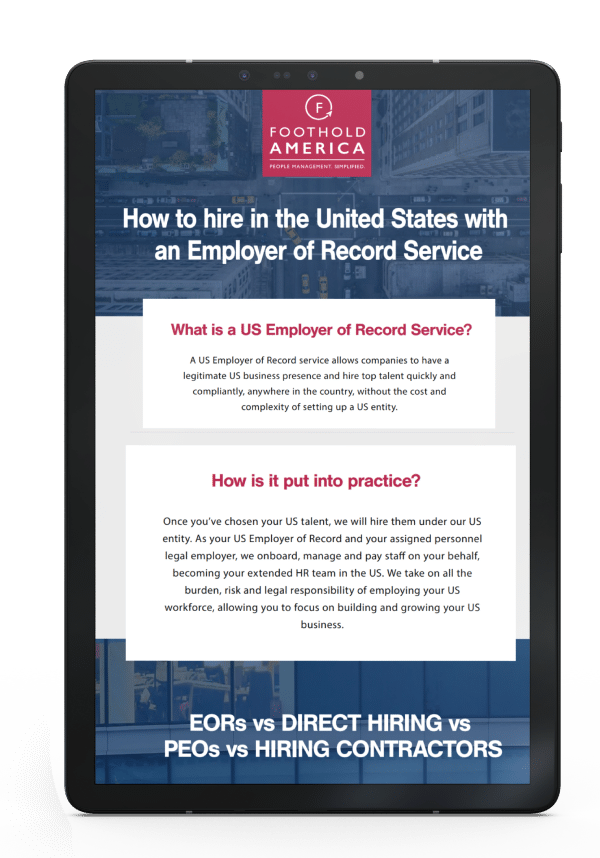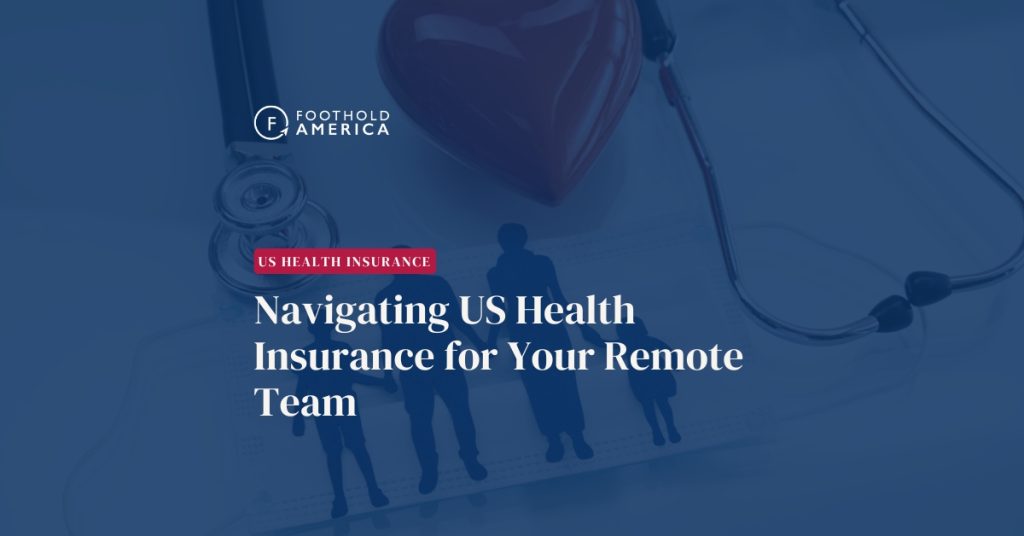Building a distributed workforce across the US grants businesses many perks, including access to a broader talent pool. However, it also introduces challenges like administering competitive healthcare benefits to employees in various states.
For businesses of all sizes, offering health insurance to employees across the US is critical for attracting and retaining top talent. However, administering benefits nationwide and maintaining compliance with state-specific regulations can be complex and time-consuming. Fortunately, there are solutions available to help you navigate these challenges.
Please read our guide to learn how to offer affordable and competitive healthcare benefits to your distributed workforce across the US.
Can health insurance work in different states?
Many US health insurance plans cover emergency services at any hospital nationwide, regardless of where you purchased the plan. However, depending on the specific healthcare plan, non-emergency care may only be covered in the state where you bought it.
Disclaimer: Always check your specific health insurance plan documents to understand the extent of your coverage, for emergency and non-emergency care, both in and out of the network. If you need clarification on your coverage, contact Foothold America directly.
Challenges of Providing Health Insurance for Remote Workers in the US
Offering health coverage across the United States presents a unique challenge due to the fragmented nature of the healthcare system. Each state has its own individual insurance mandates, regulations, and provider networks. Researching and offering state-specific plans can be time-consuming, resource-intensive, and potentially exceed your capacity or budget.
Common Challenges:
- Research: Providing flexibility for employees to work anywhere in the US is difficult when unsure about their medical coverage in different states.
- Affordability : The inability to afford multiple state-specific health plans can hinder hiring talent across the US.
- Administration: Managing a nationwide remote team and its comprehensive benefits can be complex and requires navigating HR intricacies.
- Compliance: Relocating an international employee to the US necessitates ensuring compliant relocation and continued medical coverage.
- Attraction: Offering a competitive and unique benefits package, including robust health insurance, is crucial to attract top US talent.
- Competition: Establishing a US market presence requires making medical benefits competitive against leading companies in your industry.
Navigating Healthcare for Your Distributed Workforce: 5 Options
While managing US health insurance for a geographically dispersed workforce presents challenges, several options exist. Here are five approaches, along with their advantages and drawbacks:
1. National Group Health Insurance Plan
Description: A national group health insurance plan provides the same health insurance coverage to all distributed employees across the United States, regardless of their state of residence.
Pros:
- Simplified Administration: Eliminates the need to manage and track various state-specific health insurance regulations.
- Uniform Coverage: All employees receive the same level of coverage, fostering a sense of fairness and consistency within the workforce.
Cons:
- Limited Options: Fewer health insurance companies offer national group plans, resulting in a restricted selection of plan choices for employees.
- Potentially Higher Costs: National plans often come with higher premiums and overall costs due to the broader network coverage they typically provide.
2. Separate State Health Insurance Plans
Description: This approach offers individual health insurance plans specific to each state where your distributed employees reside.
Pros:
- Tailored Coverage: Employees can choose plans that best fit their location-specific needs and preferences, potentially leading to higher satisfaction and engagement.
- Suitable for Regional Distribution: If your workforce is concentrated in specific regions, state-specific plans can provide cost-effective coverage targeted to those areas.
Cons:
- Administrative Burden: Managing and administering multiple plans with varying regulations and requirements across different states can be complex and time-consuming.
- Limited Applicability: This approach might not be feasible for geographically scattered workforces, as offering individual plans for every location could become unwieldy and expensive.
- Inequity Between Plans – Separate plans can result in different employee groups receiving various levels of coverage, which can lead to perceptions of inequity and possibly cause dissatisfaction among employees.
3. Health Reimbursement Arrangement (HRA)
Description: An HRA is a tax-advantaged account employers establish to reimburse employees for qualified medical expenses. Employers contribute a fixed amount to the account, and employees can use these funds to pay for their health insurance premiums and eligible medical costs.
Pros:
- Reduced Administrative Burden: Employers avoid the complexities of managing group health plans, simplifying their administrative duties.
- Employee Choice: Employees can choose the health insurance plan that best meets their individual needs and preferences.
- Tax Advantages: HRA contributions are tax-deductible for employers and tax-free for employees when used for qualified medical expenses.
Cons:
- Limited Investment Opportunities: Employers cannot invest the funds within the HRA accounts, potentially impacting long-term financial planning.
- Administrative complexity of managing reimbursements and tracking expenses: This creates a burden and complexity for both the employee and the employer.
- Dependence on employer funding: The amount of funds available in an HRA is determined by the employer’s contributions. If an employer reduces HRA funding, it can negatively impact the availability of funds for employees to cover their medical expenses.
- Restricted Reimbursement: Due to employer-defined rules, only qualified medical expenses are eligible for reimbursement, potentially limiting employee utilization of the funds. These rules may restrict employees’ ability to use the funds for certain medical expenses or services that they deem important.
- Forfeiture of Unused Funds: Employees lose any unused HRA funds if they leave the company, potentially creating a sense of urgency to utilize them.
4. Health Insurance Stipends
Description: A health insurance stipend is a fixed amount added to an employee’s base salary specifically intended to cover health insurance costs and potentially other benefits. It can be paid annually as a lump sum or distributed on a recurring basis.
- Employer Mandate Exemption: Businesses with fewer than 50 full-time equivalent employees can offer stipends in place of group health insurance plans to comply with ACA regulations.
The Affordable Care Act (ACA) plays a key role in determining whether employers can offer health insurance stipends. Under the ACA, employers with 50 or more full-time equivalent employees are mandated to provide affordable minimum essential health coverage to their staff.
Pros:
- Simplified Administration: Requires minimal administrative effort for employers, eliminating the complexities of managing group health plans.
- State Compliance Flexibility: Avoids compliance issues associated with varying state regulations nationwide.
- Budget Control: Employers retain control over the healthcare budget allocated through the stipend amount.
- Employee Choice: This option allows employees the freedom and flexibility to choose the health insurance plan that best suits their individual needs and location.
Cons:
- Tax Implications: Employers incur payroll taxes on the stipend amount, and employees must report it as taxable income.
- Employee Burden: The responsibility of sourcing, selecting, and managing their healthcare plan is placed on the employee, which can be time-consuming and burdensome.
5. Recommended: Utilizing an Employer of Record (EOR)
Description: An Employer of Record (EOR) is a third-party company that acts as the legal employer of your distributed workforce across the United States. The EOR assumes various employer-related responsibilities on your behalf, including administering health benefits to your employees.
Function: While the EOR legally employs your workforce, you retain complete control over day-to-day operations.
DISCLAIMER: This solution doesn’t fit all companies that operate in the US or have US employees. It suits businesses that want to hire US employees without an entity. However, it is not viable for companies that directly hire employees.
Pros:
- Comprehensive Support: EOR partners offer comprehensive legal guidance and tailor-made healthcare administration for your employees, ensuring compliance with all relevant state labor laws.
- Reduced administrative burden: With an EOR service managing benefits administration, companies can focus on core business operations and other strategic initiatives.
- Competitive Benefits: EORs can provide access to top-tier benefits plans for your distributed workforce. EOR services have established relationships with insurance providers and benefit vendors, providing companies access to comprehensive and competitive benefit options.
- Streamlined Operations: The EOR handles hiring, onboarding, payroll, and compliance, allowing you to engage and relocate talent efficiently and cost-effectively.
Cons:
- Variation in Services: Not all EOR providers offer identical plans, rates, or levels of support. Some might work with external health insurance providers, potentially impacting costs.
- Due Diligence Required: It is crucial to conduct thorough research to select the most suitable EOR partner for your specific needs.
- Limited customization and choices: The EOR may provide a standardized package that may not fully align with the company’s specific needs, potentially limiting their ability to tailor benefits to your workforce. Besides, EORs may have established partnerships with particular insurance providers or benefit vendors, giving clients limited options for choosing service providers.
Read more: What Is an Employer of Record (EOR)?
Why Businesses Choose Foothold America to Hire and Administer Benefits in the USA
If you’re seeking a streamlined and compliant way to hire employees and manage benefits for your US employees, look no further than Foothold America. Partnering with a trusted US expert with competitive benefits offerings allows you to access:
- Inclusive Coverage: Our US-focused benefits cover employees in any life and employment stage. Whether hiring a single employee or a large team, we’ll support you with customizable and comprehensive options. This grants your talent access to affordable healthcare solutions and control over their coverage choices.
- Competitive Costs: Foothold America offers affordable and competitive benefits coverage. Additionally, employers can choose a contribution level that aligns with their budget.
- Transparent Pricing: Our US-specific plans provide transparent and affordable pricing, allowing complete visibility into benefits costs. This ensures your employees know of medical costs upfront, avoiding surprises during office visits or procedures.
- Compliance Expertise: With extensive experience in US labor laws, you can trust your healthcare benefits will always be compliant. We handle the complexities of state-specific regulations, ensuring you stay compliant while focusing on your core business.
- Dedicated US Support: Our local experts always offer prompt and dedicated support to both you and your US workforce.
Don’t let benefits administration complexities hinder your ability to hire in the USA
Trust Foothold America to hire your next employee(s) in the USA. Our US-focused solution offers competitive, compliant, comprehensive packages tailored to your employees’ needs.
Foothold America takes care of the HR intricacies and challenges, allowing you to efficiently hire, onboard, and relocate top talent across the US.
Attract top US candidates with benefits that resonate. Contact Foothold America to learn more.
How to Hire in the USA with an EOR Service [eBook]
Are you planning to hire in the USA but feeling overwhelmed by the complexities of US employment law and regulations? Look no further! We have the perfect solution to simplify this process for you. Introducing our new ebook: ‘How to Hire in the USA with an EOR Service’.

GET IN TOUCH
Contact Us
Complete the form below, and one of our US expansion experts will get back to you shortly to book a meeting with you. During the call, we will discuss your business requirements, walk you through our services in more detail and answer any questions you might have.

